Retro Corner: Track & Field
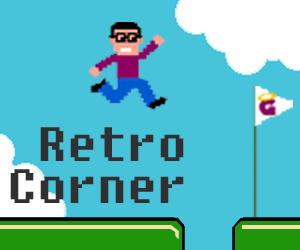 Game: Track & Field (1987)
Game: Track & Field (1987)
Developer: Konami
Publisher: Konami
Originally Released on: NES, Gameboy, Arcade, Atari, Commodore, Amstrad, Spectrum
Currently Available on: Xbox LIVE Arcade
With London 2012 just around the corner, Olympic fever has certainly in full swing. Marketing for Mario & Sonic at the Olympic Games has been re-launched, and a new SEGA London 2012 tie-in game is also on its way – not to mention the various unofficial tie-ins such as the Kinect-based Summer Stars.
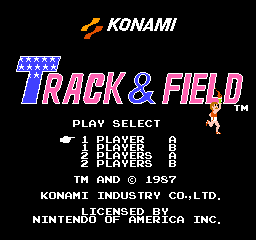 Almost every home console over the last couple of decades has had its own athletics title, or titles, ranging from the deadly serious official games, to the slightly wacky like California Games, right through to the downright oddball titles such as The Aquatic Games, stArring James Pond and the Aquabats.
Almost every home console over the last couple of decades has had its own athletics title, or titles, ranging from the deadly serious official games, to the slightly wacky like California Games, right through to the downright oddball titles such as The Aquatic Games, stArring James Pond and the Aquabats.
All of these feature similar gameplay mechanics however – that of button-mashing and twitch-response actions. And this can all be traced back to the grand-daddy of them all, the first title to popularise the control method, Track & Field by Konami. The game saw release across all of the major formats of the time, including Arcades, home computers and handhelds, and has had several iterations over the years, but the definitve version of the title was perhaps its NES release in 1987.
 Back then, the Olympic titles weren’t as comprehensive as they are nowadays. Indeed, there was no synchronised swimming on fending in sight – the title simply focused on eight of the most popular and common athletic events out there. From the orignal Arcade game, competitors could take part in the 100 Metre Dash, Long Jump, Javelin Throw, 110 Metre Hurdles, and the High Jump. But for the home release on NES, Konami added Triple Jump, Archery and Skeet Shooting – three events which had been included in the Japanese follow-up to Track & Field – therefore almost creating a “best of” collection of events for the Western NES release.
Back then, the Olympic titles weren’t as comprehensive as they are nowadays. Indeed, there was no synchronised swimming on fending in sight – the title simply focused on eight of the most popular and common athletic events out there. From the orignal Arcade game, competitors could take part in the 100 Metre Dash, Long Jump, Javelin Throw, 110 Metre Hurdles, and the High Jump. But for the home release on NES, Konami added Triple Jump, Archery and Skeet Shooting – three events which had been included in the Japanese follow-up to Track & Field – therefore almost creating a “best of” collection of events for the Western NES release.
Most of these events were controlled with two or three buttons, with the running actions all activated by the now common-place alternating tapping of two “run” buttons. For all of the events that come after the 100 Metres, a third button was is added into the mix and must be pressed to initiate a jump or to throw an object – and on top of that, for some contests, a throwing or jumping trajectory was determined by the length of the player’s button press – with players having to quickly release it again once the desired angle is reached (this all happens in a very short space of time, so good reactions are a must).
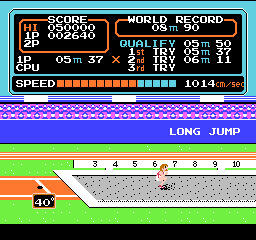 Sprint events are more straightforward – speed is of the essence, whereas throwing and jumping ones have optimum angles that will produce the best results for the players, and fault lines must not be crossed – lest they perform a foul throw.
Sprint events are more straightforward – speed is of the essence, whereas throwing and jumping ones have optimum angles that will produce the best results for the players, and fault lines must not be crossed – lest they perform a foul throw.
Skeet Shooting and archery are a bit more complex however. Skeet Shooting involves a pair of static on-screen crosshairs – one of which is fired upon by pressing on the D-Pad, the other by pressing the A button. Clay pigeons will whizz past the crosshairs, and players have to time their button presses to land hits on the targets. Combos of successful hits make the crosshairs wider, so shots become easier, but conversely when you miss one, they will shrink. And in archery, there will be a wind direction determined at the start of play, and the player has to aim their shot to make account of the wind, and hold down the button for power, depending on the distance of the target. So timing and judgement is required. These are less pick up and play than the other sports, and the feeling that they came from a seperate game is quite obvious when you play them.
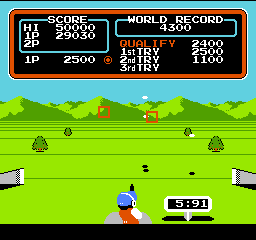 The game can be played by up to four players – taking turns during most of the events, but running in pairs for the sprint events. For each event there is a qualifying time or distance which must be met before you can move on to the next event. Players have three lives each – allowing three fails – after that it is game over. If the player reaches the “World Record” time or distance for a particular event with a successful attempt, they will be treated to a special celebration screen, along with some bonus points. Easter Eggs can even be found be reaching secret score targets, and will also reward players with bumper bonuses.
The game can be played by up to four players – taking turns during most of the events, but running in pairs for the sprint events. For each event there is a qualifying time or distance which must be met before you can move on to the next event. Players have three lives each – allowing three fails – after that it is game over. If the player reaches the “World Record” time or distance for a particular event with a successful attempt, they will be treated to a special celebration screen, along with some bonus points. Easter Eggs can even be found be reaching secret score targets, and will also reward players with bumper bonuses.
After you have successfully made your way through each event – and watched a brief medal ceremony – there is a “B” game available, whereby play restarts, but the alternate challenge level is enforced by increasing the qualifying threshold per event for the second playthrough – so you have to perform slightly better in each sport this time around.
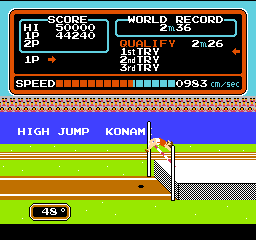 It must be said that the game is actually fairly impressive graphically for the time. Animations are quite smooth and the character sprites are bright and bold. They have quite an endearing quality to them, and have become iconically linked with memories of the game. For a game that relies on timing and speed, slow-down would be fatal, and the NES was notorious for such issues. But thankfully, Track & Field by and large avoids this pitfall and is a solid performer. The sound is basic, without becoming an irritant – and most gamers will remember the bleeping rendition of “Chariots of Fire” from the title screen, which added just the right mix of passion and cheese to proceedings.
It must be said that the game is actually fairly impressive graphically for the time. Animations are quite smooth and the character sprites are bright and bold. They have quite an endearing quality to them, and have become iconically linked with memories of the game. For a game that relies on timing and speed, slow-down would be fatal, and the NES was notorious for such issues. But thankfully, Track & Field by and large avoids this pitfall and is a solid performer. The sound is basic, without becoming an irritant – and most gamers will remember the bleeping rendition of “Chariots of Fire” from the title screen, which added just the right mix of passion and cheese to proceedings.
The gameplay may all be a bit repetitive and each event doesn’t differ very much from one to another in terms of control (aside from the shooting ones), but the appeal of the game and the pick up and play nature is shown in the endurance of the controls pioneered in this game. Athletics games today still use almost identical control methods and aside from presentational upgrades, the events have changed very little. The game is a test of your reflexes, timing and – to an extent – your endurance. Just how long and fast can you hammer those buttons for?
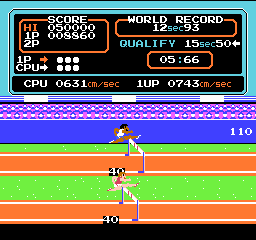 It is an instantly accessible game, that can be understood and enjoyed by people of all ages – and that is a rare thing. New updates have tried to refine it all, but the premise doesn’t need to be complex or the gameplay deep. A recent DS re-working involved stylus strokes and scribbling, but this loses the frantic tactile nature of the game somehow. Tricks like using an old ruler or the bottom of your jumper to gain an advantage at tapping the buttons are part of the charm of Track & Field – this is competition at it base form, but it works. There are few better multiplayer challenges than a group of friends trying to pound the buttons faster than one another. This would result in big arguments and great frustration, but that is what the best multiplayer titles are all about – talking points.
It is an instantly accessible game, that can be understood and enjoyed by people of all ages – and that is a rare thing. New updates have tried to refine it all, but the premise doesn’t need to be complex or the gameplay deep. A recent DS re-working involved stylus strokes and scribbling, but this loses the frantic tactile nature of the game somehow. Tricks like using an old ruler or the bottom of your jumper to gain an advantage at tapping the buttons are part of the charm of Track & Field – this is competition at it base form, but it works. There are few better multiplayer challenges than a group of friends trying to pound the buttons faster than one another. This would result in big arguments and great frustration, but that is what the best multiplayer titles are all about – talking points.
It might not have the immersion of a Kinect title where you actually jump to jump, and run to run – but you still wore yourself out and broke a sweat by trying your hardest to pummel the buttons. So grab a few friends and prepare to see what old-school multiplayer competition was all about: not so much blood, but plenty of sweat and tears.
A High Definition re-working of Track & Field can currently be found on Xbox LIVE arcade. The official London 2012 Olympics game will be out later this month. Retro Corner will return on the first Friday of next month. You can see previous entries into the GodisaGeek Retro Corner by clicking here.






